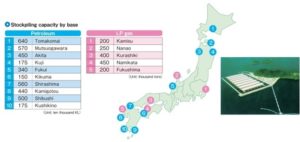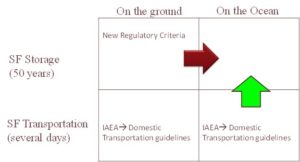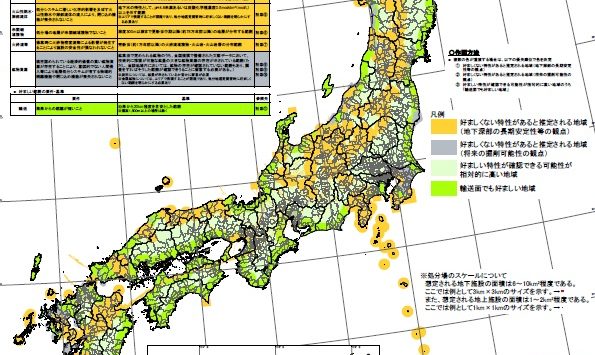KAE TAKASE AND DAVID VON HIPPEL
October 20, 2017
I. INTRODUCTION
In this report, Kae Takase and David von Hippel review the history and current status of interim storage of spent nuclear fuel in Japan. They examine the obstacles to changing current policy, and note that transparency of policy formation related to spent fuel storage technology and siting is central to achieving public support for any revision of current policies. They outline the pros and cons of a coastal barge-based scheme for interim spent fuel storage in dry casks, noting that further work is needed to assess the relative advantages of implementing such an approach in Japan.
Please note that a summary and conclusions of the authors’ full report, as well as the Table of Contents of the full report, are provided below. The full report itself, including the full technical analysis is available as a PDF file [3.9MB] here.
Kae Takase directs the Governance Design Laboratory, Tokyo and David F. von Hippel is a Senior Associate, Nautilus Institute
Paper prepared for Workshop Reducing Risk of Nuclear Terrorism and Spent Fuel Vulnerability in East Asia co-sponsored by Nautilus Institute and Research Center for the Abolition of Nuclear Weapons, Nagasaki University, Nagasaki, January 20-22, 2017
The views expressed in this report do not necessarily reflect the official policy or position of the Nautilus Institute. Readers should note that Nautilus seeks a diversity of views and opinions on significant topics in order to identify common ground.
Banner image: Color-coded map identifies potential nuclear waste sites in Japan, from here
II. NAPSNET SPECIAL REPORT BY KAE TAKASE AND DAVID VON HIPPEL
OPTIONS FOR REMOTE INTERIM STORAGE OF NUCLEAR SPENT FUELS IN JAPAN
October 20, 2017
I. Summary
Japanese nuclear utilities are currently holding approximately 15,000 tonnes of spent fuel in spent fuel pools at reactor sites and in the spent fuel pool at the Rokkasho reprocessing facility. Much of the spent fuel in storage in spent fuel pools in Japan is in “dense packed” pools, which are significantly more vulnerable to fire and subsequent radiation release in the event of coolant loss due to accident or attack than are pools using non-dense-packed arrays. Moving cooled spent fuel out of spent fuel pools and into dry cask storage—in which dry spent fuel is stored in an inert atmosphere in massive steel and concrete casks—would reduce the vulnerability of the spent fuel in storage to terrorist attack or accidents. Moving Japan’s cooled spent fuel to one or more remote interim dry storage facilities would provide this type of vulnerability reduction, but faces numerous challenges. Some of these challenges are technical—largely identifying suitable sites and developing or adapting transport infrastructure—but most of the obstacles to interim spent fuel storage in Japan are political, social, and institutional.
Interim spent fuel facilities, both at-reactor and away-from reactor, are in used in and or proposed for use in a number of countries. Elements of such facilities typically include dry casks, the structures in or on which casks are placed, transportation and handling systems, and security and monitoring systems. For Japan, three options for siting of interim spent fuel facilities include coastal, and island locations, both of which benefit from easy transportation of spent fuel by sea to the facilities, and barge-mounted spent fuel storage, with one or a set of barges anchored at sea in protected locations such as inland waters off Japan.
For most of its history with nuclear power, Japanese official policy has been to recycle the plutonium in spent light-water reactor fuel to mixed oxide (MOx) fuel, with the use of MOx in either light water reactors (the “pluthermal” approach) or, eventually, in Fast Breeder Reactors (FBRs). The operation of Rokkasho has been delayed many times, and pool storage facilities at existing nuclear power plants are expected to be filled up shortly as reactors are restarted following extensive post-Fukushima safety review. Moving spent fuel from full spent fuel pools to pools at other reactors with available space is prohibited under the agreements between reactor operators and local municipalities. Although the continuing emphasis on plutonium recycle has been an impediment to development of interim spent fuel storage, a dry-cask-based facility has been built at Mutsu, near Rokkasho, and is scheduled to being operations in 2018. Dry cask storage is also used at the Fukushima site, and is planned for at least one other reactor site.
The required attributes of an interim spent fuel storage site, whether coastal, island-based, or barge-mounted, include:
- A location that is relatively remote from significant populations, and is protected as much as possible from seismic and tsunami hazards, as well as being relatively easy to secure and defend in the case of an attack scenario;
- A location that is accessible to berthing facilities so that spent fuel can be brought in from Japanese coastal reactors by ship, and can easily be transported from docks to the facility, preferably without transiting high-traffic areas. The facility itself would need to include equipment and processes for accepting and moving dry casks, and storing the casks, as well as monitoring and other security equipment and processes;
- And perhaps most importantly, a location where local residents, and local and regional government agencies, are accepting of the facility, or can be convinced to accept the facility through a process of consultation and offers of compensation.
Barge-mounted spent fuel storage would be new to Japan, and as a consequence faces a barrier of precedence—facilities not already demonstrated in similar countries are less likely to be adopted in Japan—but also pose a regulatory puzzle, as the safety criteria now applied to spent fuel storage in Japan are entirely land-based. That said, the presence of barge-based offshore petroleum stockpiles in Japan serves as an interesting precedent for barge-based spent fuel storage, and barge-based systems may provide ways around some siting issues.
The lack of public acceptance is a major challenge for siting new interim spent fuel facilities in Japan. Regulation of nuclear facilities has become stricter in the aftermath of the Fukushima accident, and it requires considerable effort and time for a new facility, or even an updated existing facility, to obtain approval by the Nuclear Regulation Authority. That said, a compensation scheme for the hosts of nuclear facilities, including spent fuel storage facilities, is well established in Japan, so that less-populated and depopulated municipalities in particular (where payments are spread over a smaller population, and where the towns lack industries or other economic activities) should have significant motivation to host interim storage facilities. Siting facilities on uninhabited islands, leaving (presumably) more compensation to be retained at the prefecture level and for communities not immediately adjacent to the facility, may be attractive.
Given the difficulties of siting spent fuel storage in Japan, it is likely that Japan would be receptive to discussing potential regional collaborations on spent fuel storage facilities.
Japanese electric companies and the agencies of the Japanese government involved with the nuclear sector are now aware of the importance of dry cask storage, and dry cask storage is now preferred to spent fuel pools, at least officially, since it offers advantages in costs and safety. What Japan lacks is public acceptance of spent fuel facilities, as well as open, transparent, and inclusive processes for public disclosure and discussion on nuclear sector matters. It is very important to have all processes in which Japan’s nuclear future are discussed be open, and to prepare good discussion platforms in order to foster public acceptance.
2. Conclusions
Attributes of Sites for Remote Interim Spent Fuel Storage Facilities
The largest problem for siting interim spent fuel storage facilities is public acceptance. Even though dry cask technology has a relatively low risk of radiological release as a result of accident or attack, the public’s general reluctance to accept any type of nuclear- related facilities near their own communities still exists. Japan already has a scheme to provide a large amount of compensation to the prefectural and local governments hosting interim spent fuel storage facilities, with the compensation continuing for long periods of time, and the offer of these grants can attract prefectural governments to consider hosting interim storage facilities on, for example, islands within the prefectural territory. Islands offering a solid geological setting may be possible host locations. The Japan Agency for Marine-Earth Science and Technology (JAMSTEC) has started to consider doing research for final deep borehole disposal in Minamitori Island, which is a part of the Tokyo prefecture, but has no residents. Minamitori Island has a stable geology, and can be a candidate not only for the deep borehole final disposal experiment, but also for the interim spent fuel storage.
Japan has a history of siting nuclear-related facilities in coastal areas, typically areas with low population densities. Coastal locations make it easy to get cooling water for the reactors. Coastal area also offer advantages in transporting nuclear fuel, both fresh fuel and spent fuel, by ship, which is the only transport mode that Japan has used to date for commercial reactor spent fuel (with the exception of short distances from nuclear facilities to ship berths, which are handled by truck).
With respect to potential barge-mounted interim storage facilities, Japan has potentially relevant experience related to operating two oil stockpiling facilities on barges/vessels (see Figure 7‑1. Since all the safety criteria related to the storage of nuclear spent fuel have been developed assuming the storage structure sits on the ground, it would likely require a large effort to develop new safety criteria for the spent fuel facilities located on barges/vessels.

Figure 7‑1: Oil Stockpiling Facilities in Japan (Shirashima and Kamigotou are on barges/vessels)
Key Barriers and Challenges to Implementation of Remote Interim Spent Fuel Storage
Facilities in Japan
As discussed in the previous section, the lack of public acceptance is a major challenge for siting new interim spent fuel facilities in Japan. Also, the regulation of nuclear facilities has become more strict in the aftermath of the Fukushima accident, and it is very hard to for a new facility, or even an updated existing facility, to obtain approval by the Nuclear Regulation Authority.
A compensation scheme for the hosts of nuclear facilities, including spent fuel storage facilities, is well established, so that less-populated municipalities in particular (where payments are spread over a smaller population) should have significant motivation to host interim storage facilities.
Earthquake are very frequent in Japan, and as was observed following the Great East Japan Earthquake, there is the possibility for large tsunamis following earthquakes. This is of particular concern for siting spent fuel storage in coastal areas, on islands, and on barges or vessels. Still, an important empirical example, is that spent fuel in dry casks already stored at Fukushima Daiichi power plant at the time of Great East Japan Earthquake safely survived the tsunami that severely damaged many other systems at the Fukushima plant.
Based on risks related to earthquakes and tsunamis, coastal or island-based spent fuel storage would likely be safer than barge-mounted or ship-based storage, since dry casks are very heavy, and would not be affected by a tsunami if land-based, but would create a significant problem associated with cask recovery if a barge or vessel holding spent fuel was wrecked, and the casks sank into the ocean.
A practical advantage of island-based storage related to compensation grants and winning approval for siting at the prefectural level is that, especially on islands without residents, the prefectural government could receive compensation for hosting the facility, even though there are no people living on the island and thus no municipality directly hosting the facility.
Next Steps
It is very important for potential developers of spent fuel storage facilities to clearly disclose both the risks and merits of hosting such facilities. The transparency of the process of siting nuclear facilities in Japan has been improving, but additional effort to inform the public about risks, benefits, options, and the current spent fuel management situation will be required.
For potential barge/vessel-based spent fuel storage facilities, since Japan already transports spent fuel by ship, and operates oil stockpile facilities on barges/vessels, it may be possible to develop regulations/guidelines for barge/vessel-based storage from the starting point of the safety criteria already used for spent fuel transportation by ship, rather than from the existing land-based spent fuel storage criteria, which are a poor match to the situation of storage of spent fuel at sea and would take considerable time and effort to adapt to barge/vessel-based storage. The difference between spent fuel transportation and spent fuel storage on barge/vessels is only the duration of storage, suggesting that a more streamlined approach to developing safety standards for spent fuel storage at sea could be possible (see Figure 7‑2).

Figure 7‑2: Possible Approaches to Developing Guidelines/and Criteria for Barge/vessel Spent Fuel Storage in Japan
Japanese electric companies and the agencies of the Japanese government involved with the nuclear sector are now aware of the importance of dry cask storage, and dry cask storage is now preferred to spent fuel pools and reprocessing, at least officially, since it offers advantages in costs and safety. What Japan lacks is public acceptance of spent fuel facilities, as well as open, transparent, and inclusive processes for public disclosure and discussion on nuclear sector matters. It is very important to have all processes in which Japan’s nuclear future are discussed be open, and to prepare good discussion platforms in order to foster public acceptance.
3. Table of Contents of Full Report available here
SUMMARY..
Table of Contents.
Table of Figures.
Table of Tables.
1 Introduction.
1.1 Background.
1.2 Dry Cask Storage Internationally and in Japan.
1.3 Contents of this Report
2 International Experience with and Proposals for Remote Interim Spent Fuel Storage.
2.1 Typical Components of Interim Spent Fuel Storage Facilities.
2.1.1 Dry Cask Storage.
2.1.2 Dry Cask Emplacements.
2.1.3 Transportation and Handling Systems.
2.1.4 Site Security and Monitoring Systems.
2.2 Spent Fuel Storage in Coastal Locations.
2.3 Spent Fuel Storage on Islands.
2.4 Spent Fuel Storage on Barges and Other Vessels.
3 Japanese Proposals for Remote Interim Spent Fuel Storage Facilities.
3.1 Introduction.
3.2 History of Spent Fuel Storage in Japan.
3.3 Description of Existing Remote Interim Spent Fuel Storage Facilities.
3.4 Discussions of Other Interim Spent Fuel Storage Facilities in Japan.
3.5 Lessons from Previous Discussions of Interim Spent Fuel Storage Options in Japan.
4 Elements of a Generic Interim Spent Fuel Storage Facility for Japan.
4.1 Review of Key Attributes Based on Existing Literature.
4.2 Siting Requirements.
4.3 Spent Fuel Transport and Handling Infrastructure.
4.4 Political/Social/Community Attributes of Interim Spent Fuel Storage Site.
4.5 Relative Advantages and Disadvantages of Coastal, Island, and Barge-mounted Interim Spent Facilities
4.6 Areas of Japan Where Interim Spent Fuel Storage Might be Located.
5 Remote Interim Spent Fuel Storage in Japan versus Existing Storage Systems.
5.1 Relative Political/social/institutional Attributes of Remote versus Existing Systems.
6 Social and Political Barriers and Challenges to Developing an Remote Interim Spent Nuclear Fuel Storage Facility.
6.1 Opposition to Interim Spent Fuel Storage by the Nuclear Industry in Japan.
6.2 Opposition to Interim Spent Fuel Storage by Residents of Host Regions.
6.3 Attitudes toward Interim Spent Fuel Storage by Civil Society Organizations in Japan.
6.4 Existing Laws and Arrangements with Current Nuclear Facility Host Communities.
7 Conclusions.
7.1 Attributes of Sites for Remote Interim Spent Fuel Storage Facilities.
7.2 Key Barriers and Challenges to Implementation of Remote Interim Spent Fuel Storage Facilities in Japan
7.3 Next Steps.
The full report itself, including the full technical analysis is available as a PDF file [3.9MB] here.
III. NAUTILUS INVITES YOUR RESPONSE
The Nautilus Asia Peace and Security Network invites your responses to this report. Please send responses to: nautilus@nautilus.org. Responses will be considered for redistribution to the network only if they include the author’s name, affiliation, and explicit consent


